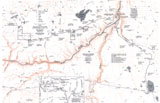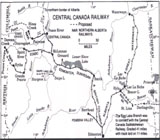The Central Canada Railway
Incorporation and Financing
J.D. McArthur’s strategy in incorporating and building the initial portion of this railway may have been two-fold. The Edmonton Dunvegan and British Columbia Railway (ED&BCR) passed south of Peace River Landing but McArthur saw an opportunity to tap into the Peace River navigation traffic by building the Central Canada Railway from his ED&BCR line. By 1913 it had become clear that none of the railways projected to serve Peace River, in particular the Canadian Northern Railway from Athabasca to Peace River were going to enter that area. Secondly the line would serve the rich fertile farm lands of the Peace River country along the north (west) bank of the river. The agricultural potential of this land had already been proven by the long established Shaftsbury settlement along the north (west) bank of the river. By 1915 several townships of land in this area had either been sold or reserved.2 The CCR would become a feeder line to the ED&BCR.
Consistent with its prevailing railway support policy the Government of Alberta guaranteed the payment of principal and interest of the bonds, debentures, debenture stock and other securities of the company to the extent of $20,000 per mile for a distance of 100 miles.3 McArthur however was unable to sell the bonds as the commencement of World War I had severely constricted the availability of money on the world financial markets. Since there was some urgency to reach the lead of navigation at Peace River Landing, the Government of Alberta in 1914 advanced $2,000,000 to the CCR on the security of unsold bonds.4
Construction
By the close of 1914 grading from the ED&BCR junction to Reno (mile 24.1) had been completed.5 McArthur and his engineers had to make a decision about which route the railway would follow down into the valley to reach Peace River Landing. One proposal was to follow a gradual but very expensive 18 mile grade down the North Heart River valley, also known as the Harmon River, criss-crossing the river on 60 bridges and then proceeding along the valley floor into Peace River Landing.6 Engineers feared that the danger of slides resulting from the cut backs would make this route too difficult to maintain.7
The railway chose a less expensive route. The line would proceed beyond Reno on the level Prairie and then begin the 700 foot descent into the Peace River valley from the bank about 2 miles west of mouth of the Smoky River. This alternative necessitated the building of a 600 foot long, 140 foot high bridge across the North Heart River.8 It also resulted in a steep 2.4% railway grade. By October 1915 the track had reached the top of the grade at a point named Judah.9 By the close of the grading season (late fall 1915) the roadbed had been prepared beyond the Heart River bridge site and to a point one and one-half miles short of the proposed Peace River station site. Steel was laid down the hill to the bridge site.10 In the summer of 1916 the bridge was completed.
Operations
The first train operated into Peace River on August 11, 1916. Orders authorizing the operation of this position of the line from mile 0 at Winagami Junction to mile 48.6 was issued by the Government of Alberta on January 13, 1917.11
While this railway crossed unsettled land it stimulated the economy in that area, McArthur founded the Peace River Oil Company in 1916. He brought machinery into the area by rail and struck oil on Tar Island 17 miles downstream from Peace River. It was at this time that Lord Rhondda (D.A. Thomas) entered the area. He purchased the Peace River Trading and Land Company and opened up a steam boat service on the Peace River.12 This link with steamboat service on the Peace/Athabasca system stimulated trade upriver to Fort St. John., B.C. and down river to Fort Vermilion and points further north. The railway’s arrival at Peace River had the impact of stimulating further interest in the excellent agricultural land west or north of the river. Settlers anticipated that a planned extension to the railway would soon bring it across the river and through the centre of this prime land. The railway’s presence did result in some land being taken up in the Judah area and in the area east of the Hart River east of Nampa on the railway.13
Peace River Bridge
McArthur continued work on this line with the building of a 2700 foot long bridge across the Peace River. The proposed permanent roadway portion was never completed but the railway portion of the bridge deck was planked to allow the operation of roadway traffic across the bridge.14 Work began in February 1917. The bridge was completed in November 1918. The Dominion Government paid a subsidy of $175,000 while the Provincial Government paid a subsidy of $110,000. The latter withheld $65,000 as the permanent highway side brackets had not been placed.15
Some preliminary clearing and grading took place during 1917 or 1918 on the west or north side of the river. From mile 49 to mile 64 it had been partly cleared and partly graded. Between mile 64 and 80 the line had only been partly cleared.16
Grouard
Shortly after the original Central Canada charter was granted. McArthur was faced with pacifying the Town of Grouard as the ED&BCR line had passed to the south of that community 1913. The October 1914 the Alberta Legislature asserted to an amendment to the Act incorporating the Central Canada Railway Company that gave the company the right to construct and operate a line of railway from a point in the vicinity of Sucker Creek on the ED&BCR to a point to or through Grouard.17 This was the branch line McArthur had agreed to build as an alternative to having the ED&BCR main line serve the town and the surrounding settlements. The provincial government guaranteed the bonds for this line. In spite of continuing petitions from the people of Grouard the line was never built.
McArthur’s Plans
McArthur presented yet another petition to the Alberta Legislature in 1915 to further amend the Central Canada Railway charter.18 He proposed to build a line from a point on the Alberta and Great Waterways Railway north of the township line between townships 64 and 65 in an easterly and south easterly direction through the settlements of Bonnyville and Durlingville to the eastern boundary of the province. During the winter of 1916–17 McArthur actually built a line that left the A&GWR on the northern boundary of township 66 between the settlements of Hylo and Venice. Commonly known as the Egg Lake branch it headed in a south easterly direction toward the settlements of Grandin and St. Lina. Eleven miles were laid in steel to serve the timber berths of McArthur’s North West Lumber Company.
McArthur apparently had a greater vision for this line. He had plans to extend the line to the Saskatchewan border with the apparent intention of connecting with a line he had chartered in both the provinces of Saskatchewan and Manitoba.19 The Saskatchewan charter was called the Central Canada Saskatchewan Railway and gave McArthur’s company power to build from the Alberta-Saskatchewan border to Prince Albert. McArthur first chartered the Central Canada Railroad and Power Company under the statutes of Manitoba in 1905. It allowed the company to generate electricity to supply water from the Winnipeg River and to construct a railway line from Winnipeg to Selkirk to a point or points near the Winnipeg River. A 1911 amendment gave the company the right to construct a main line of railway from either Winnipeg or St. Boniface to the Winnipeg River and then north to the northern boundary of the province. A third amendment of 1917 gave the company the right to extend the railway to the western boundary of the province of Manitoba between latitudes 55 and 56. This would bring the line around the north shore of Lake Winnipeg. McArthur appeared to plan to tap the resources of northern Manitoba before he became involved in building the Alberta railways and developing forest, oil and agricultural resources in Alberta. Edmonton and northern Alberta because of geographical location and political climate provided an excellent opening for McArthur to begin to develop his vision. Here the northern natural resources could be accessed by railways financed by government guaranteed bonds that supported government agricultural development policy. By 1911 when McArthur became involved in the ED&BCR the government was seeking a person or a consortium with McArthur’s vision and financial means to open up the resources of northern Alberta. Once McArthur’s railway and business interests were underway his strategy appeared to be to connect Winnipeg with the Peace River country by way of a railway network across the northern prairies.
Another amendment to the Central Canada Railway Act dated 1917 authorized the construction of a railway line from the ED&BCR at or near High Prairie south and west to Snipe Lake and to the sixth meridian.20 It would appear that the line’s purpose was to access timber resources and encourage agricultural settlement.21 As with the proposed branch from Peace River to the Notekewin (Battle) River (1913) and Grouard (1914) this Central Canada project never became more than a chartered proposal.
Alberta Government Obligations
A forest fire in 1919 rendered the land along the Egg Lake branch useless for both logging and agricultural purposes. McArthur did not add any new mileage to the CCR after the summer of 1919. The Alberta government took over the Central Canada Railway in July 1920. The resulting management agreement between the government and the CPR included the CCR line between Winogami junction and Peace River.22
The government of Alberta faced a dilemma in 1921 as it considered expenditures to extend the CCR into the partly settled fertile farm lands along the north or west bank of the Peace River. While the Peace River bridge had been completed in November 1918 it stood dormant to railway traffic for almost three years as there were no tracks leading from the bridge onto the west bank of the river. The Alberta government had committed itself to investing heavily in the rehabilitation of the northern lines as part of the 1920 agreement with the CPR to operate these lines. Quite apart from its financial obligations to the CPR agreement the government also had responsibility for financing a third McArthur property, the failed Alberta and Great Waterways Railway. In early 1921 as when prices were dropping and there was no hay crop to move south, the CPR claimed losses of up to $30,000 a month in managing the ED&BCR and the CCR lines. The government also faced a heavy debt.23 Finally Premier Stewart arranged for $600,000 to be voted in the Legislature for the construction of 25 miles of line from the Peace River bridge to Berwyn.24 This money was raised in the form of a loan. The government held a first mortgage on the Central Canada Railway property to secure the loan. The government entered into an agreement with the CPR to construct this 25 miles of line.
Since considerable deterioration had occurred to portions of the original 1917 grade on the west bank of the river a revised location was selected. It involved an increase in gradient but resulted in a saving of 1.7 miles in distance. By the close of the year 1921 23.6 miles of track had been laid down to Berwyn.25 This new section opened on January 20, 1922 under the authority of a provincial order.
Extensions
Negotiation for the construction of the next 13.0 mile extension to Whitelaw moved more slowly even though the new United Farmers of Alberta Government under Premier Charles Stewart continued supporting railway expansion. The UFA did decide to call tenders of the Berwyn to Whitelaw extension rather than contracting with the CPR to carry out the work. While the CPR did not sign the agreement to operate the proposed extension until September 1923, the government did call and award construction tenders before the agreement was signed. Grading commenced from Berwyn in September 1923. Due to the high cost of new rails the government decided to purchase used rails. These were not delivered until the spring of 1924.26 Poor weather further delayed the work. On December 9, 1924 the line was turned over to the CPR for operation.27
In 1928 the Alberta Legislature voted a sum of $1,200,000 to be applied to two railway extension projects in the Peace River and Grande Prairie areas.28 Some $435,000 was appropriated to the CCR extension. Work began on May 22, 1928 and the 13-mile extension from Whitelaw to Fairview was opened for operation by November 2, 1928. Buildings from the village of Waterhole were moved north some three miles in order to be located on the railway at Fairview.29 The railway from Berwyn to Bluesky closely followed a portion of the old cart trail that originated at Shaftsbury. The trail then arched through the center of the fertile plain and at Bluesky began a long curve south and west that brought it down to the river again at Dunvegan. Before the railway arrived, farmers carted their produce to either Shaftsbury or Dunvegan where it was transferred to a steamboat and taken to the railhead at Peace River. From Dunvegan most farmers crossed the river by ferry and continued their journey south to deliver their produce to the rail head at Spirit River.30 The railway improved the life of settlers in this area, encouraged the development of more economically viable farms, and promoted the general economic growth of the area. The Central Canada Railway became part of the newly formed Northern Alberta Railways in 1929 under an Alberta government agreement with the CPR and the CNR to takeover the four northern railways.31
Notes | Bibliography | Abbreviations
1. Alberta, 4 George V, Chapter 46, 1913 (1).2. Department of the Interior, Canada, Map of Northern Alberta corrected to 1 January 1916.
3. Provincial Archives of Alberta 84.388, File 1100.140.1.
4. J.D. Williams, “A History of the Edmonton, Dunvegan and British Columbia Railway, 1907–1929” (Thesis, Dept. of History, University of Alberta, 1956), p. 65.
5. Ibid., p. 62.
6. Ibid.
7. Ibid., p. 69.
8. Ibid.
9. Ibid.
10. Ibid., pp. 69–70.
11. PAA 86.587, File 3468, Provincial Order.
12. Williams,“A History of the Edmonton,” p. 76.
13. Department of the Interior, Canada, Map of Northern Alberta corrected to January 1, 1916, and October 1, 1919.
14. Public Archives of Canada, RG 43, Vol. 556, File 17773A, Part 1, Report from A. Ferguson, Inspecting Engineer to G.A. Bell, Deputy Minister, Department of Railways and Canals, Ottawa, 26 April 1920.
15. Ibid.
16. 1bid.
17. Alberta, 5 George V, Chapter 30, 1914.
18. Ibid., Chapter 36, 1915.
19. Manitoba, 7 George V, Chapter 104, 1917, Central Canada Railroad and Power Company; Saskatchewan, 7 George V, Chapter 43, 1917, Central Canada Saskatchewan Railway Company; Saskatchewan, 4 George V, Chapter 69 (e), 1913, Central Provinces Railway Company.
20. Alberta, 7 George V, Chapter 53, 1917.
21. M. Zaslow, “A History of Transportation and Development of the Mackenzie Basin from 1871–1921” ( Dissertation, University of Toronto, 1948), p. 357.
22. See ED & BCR.
23. Williams, “A History of the Edmonton,” pp. 118–19.
24. Ibid., p. 121.
25. Department of Railways and Telephones, Annual Report, 1921.
26. Williams, p. 126.
27. Department of Railways and Telephones, Annual Report, 1924.
28. Williams, p. 191.
29. Department of Railways and Telephones, Annual Report, 1928.
30. F.H. Kitto, The Peace River District, Canada: Its Resources and Opportunities (Ottawa: Dept. of the Interior, 1930), p. 27.
31. Ena Schneider, Ribbons of Steel: The Story of the Northern Alberta Railways (Calgary: Detselig Enterprises, 1989), p. 145.


